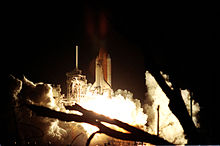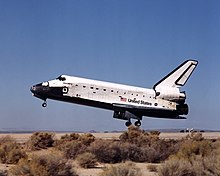 Wisoff oversees PMA-3 (top) being mated with the nadir port of Unity (bottom) during EVA 2 Wisoff oversees PMA-3 (top) being mated with the nadir port of Unity (bottom) during EVA 2 | |
| Names | Space Transportation System-92 |
|---|---|
| Mission type | ISS assembly |
| Operator | NASA |
| COSPAR ID | 2000-062A |
| SATCAT no. | 26563 |
| Mission duration | 12 days, 21 hours, 42 minutes, 42 seconds |
| Spacecraft properties | |
| Spacecraft | Space Shuttle Discovery |
| Launch mass | 115,127 kg (253,812 lb) |
| Landing mass | 92,741 kg (204,459 lb) |
| Payload mass | 9,513 kg (20,973 lb) |
| Crew | |
| Crew size | 7 |
| Members | |
| EVAs | 4 |
| EVA duration |
|
| Start of mission | |
| Launch date | 11 October 2000, 23:17:00 (2000-10-11UTC23:17Z) UTC (6:17 pm EST) |
| Launch site | Kennedy, LC-39A |
| End of mission | |
| Landing date | 24 October 2000, 20:59:42 (2000-10-24UTC20:59:43Z) UTC (12:59:42 pm PST) |
| Landing site | Edwards, Runway 22 |
| Orbital parameters | |
| Reference system | Geocentric |
| Regime | Low Earth |
| Perigee altitude | 386 km (240 mi) |
| Apogee altitude | 394 km (245 mi) |
| Inclination | 51.6° |
| Period | 92.3 minutes |
| Docking with ISS | |
| Docking port | Unity forward |
| Docking date | 13 October 2000, 17:45 UTC |
| Undocking date | 20 October 2000, 15:08 UTC |
| Time docked | 6 days, 21 hours, 23 minutes |

 From left: Chiao, Melroy, Lopez-Alegria, McArthur, Wisoff, Duffy and WakataSpace Shuttle program← STS-106 (99)STS-97 (101) → | |
STS-92 was a Space Shuttle mission to the International Space Station (ISS) flown by Space Shuttle Discovery. STS-92 marked the 100th mission of the Space Shuttle and Discovery's 28th flight. It was launched from Kennedy Space Center, Florida, 11 October 2000.
Crew
| Position | Astronaut | |
|---|---|---|
| Commander | Fourth and last spaceflight | |
| Pilot | First spaceflight | |
| Mission Specialist 1 | Third spaceflight | |
| Mission Specialist 2 Flight Engineer |
Third spaceflight | |
| Mission Specialist 3 | Fourth and last spaceflight | |
| Mission Specialist 4 | Second spaceflight | |
| Mission Specialist 5 | Second spaceflight | |
Spacewalks
- EVA 1
- Personnel: Chiao and McArthur
- Start: 15 October 2000 – 14:27 UTC
- End: 15 October 2000 – 20:55 UTC
- Duration: 6 hours, 28 minutes
- EVA 2
- Personnel: López-Alegría and Wisoff
- Start: 16 October 2000 – 14:15 UTC
- End: 16 October 2000 – 21:22 UTC
- Duration: 7 hours, 7 minutes
- EVA 3
- Personnel: Chiao and McArthur
- Start: 17 October 2000 – 14:30 UTC
- EVA 3 End: 17 October 2000 – 21:18 UTC
- Duration: 6 hours, 48 minutes
- EVA 4
- Personnel: López-Alegría and Wisoff
- Start: 18 October 2000 – 15:00 UTC
- End: 18 October 2000 – 21:56 UTC
- Duration: 6 hours, 56 minutes
Crew seat assignments
| Seat | Launch | Landing |  Seats 1–4 are on the flight deck. Seats 5–7 are on the mid-deck. |
|---|---|---|---|
| 1 | Duffy | ||
| 2 | Melroy | ||
| 3 | Wakata | Lopez-Alegria | |
| 4 | McArthur | ||
| 5 | Wisoff | ||
| 6 | Lopez-Alegria | Wakata | |
| 7 | Chiao | ||
Mission highlights



| Attempt | Planned | Result | Turnaround | Reason | Decision point | Weather go (%) | Notes |
|---|---|---|---|---|---|---|---|
| 1 | 5 Oct 2000, 9:38:26 pm | Scrubbed | — | Technical | 60 | Problems developed with ET separation bolts and a main propulsion system valve on Discovery. | |
| 2 | 9 Oct 2000, 8:05:17 pm | Scrubbed | 3 days 22 hours 27 minutes | Technical | 9 Oct 2000, 9:00 am | 30 | High winds prevented pre-launch preparations. |
| 3 | 10 Oct 2000, 7:39:36 pm | Scrubbed | 0 days 23 hours 34 minutes | Technical | 10 Oct 2000, 6:30 pm | 70 | A metal pin was found wedged in between the orbiter and external tank in an area that technicians could not access. There was a risk that the pin could dislodge during launch and damage the shuttle. |
| 4 | 11 Oct 2000, 6:17:00 pm | Success | 0 days 22 hours 37 minutes | 80 |
STS-92 was an ISS assembly flight that brought the Z1 truss, Control Moment Gyros, Pressurized Mating Adapter-3 (PMA-3) (mounted on a Spacelab pallet) and two DDCU (Heat pipes) to the space station.
The Z1 truss was the first exterior framework installed on the ISS and allowed the first U.S. solar arrays to be temporarily installed on Unity for early power during flight 4A. The Ku-band communication system supported early science capabilities and U.S. television on flight 6A. The CMGs (Control Moment Gyros) weigh about 27 kilograms (60 lb) and provide non-propulsive (electrically powered) attitude control when activated on flight 5A, and PMA-3 provides shuttle docking port for solar array installation on flight 4A and Destiny Lab installation on flight 5A.
The mission included seven days of docked operations with the space station, four EVAs, and two ingress opportunities.
Over the course of four scheduled spacewalks, two teams of space walkers and an experienced robot arm operator collaborated to install the Z1 (Z for zenith port) truss structure on top of the U.S. Unity connecting node on the growing station and to deliver the third Pressurized Mating Adapter (PMA 3) to the ISS for the future berthing of new station components and to accommodate shuttle dockings.
The Z1 truss was the first permanent lattice-work structure for the ISS, very much like a girder, setting the stage for the future addition of the station's major trusses or backbones. The Z1 fixture also served as the platform on which the huge U.S. solar arrays were mounted on the next shuttle assembly flight, STS-97. The Z1 truss included many elements of the Communications and Tracking subsystem. The hardware included a Transmitter/Receiver/Controller (SGTRC) built by L3 Communications Systems-East in Camden, NJ. John Schina was the Chief Engineer of the ISS Program at L3.
The Z1 contains four large gyroscopic devices, called Control Moment Gyroscope (CMGs), which are used to maneuver the space station into the proper orientation on orbit once they were activated following the installation of the U.S. laboratory.
During the fourth spacewalk, astronauts Wisoff and López-Alegría tested the SAFER jet backpack, flying up to 50 feet while remaining tethered to the spacecraft.
Media
See also
- List of human spaceflights
- List of International Space Station spacewalks
- List of Space Shuttle missions
- List of spacewalks 2000–2014
- Outline of space science
References
- ^ Ryba, Jeanne (15 February 2010). "STS-92". Mission Archives. NASA. Archived from the original on 14 March 2022. Retrieved 17 April 2022.
- Petty, John Ira (11 October 2000). "STS-92 Mission Control Center Status Report #1". Johnson News. Johnson Space Center. Archived from the original on 8 April 2013. Retrieved 17 April 2022.
- Dunn, Marcia (12 October 2000). "100th shuttle mission in orbit". Wisconsin State Journal. Associated Press. p. 3. Archived from the original on 17 April 2022. Retrieved 17 April 2022 – via Newspapers.com.
- Siceloff, Steven (3 October 2000). "Female shuttle pilot puzzled by attention". Florida Today. p. 11. Archived from the original on 17 April 2022. Retrieved 17 April 2022 – via Newspapers.com.
- Young, Kelly (18 October 2000). "Astronauts attach power converters". Florida Today. p. 29. Archived from the original on 17 April 2022. Retrieved 17 April 2022 – via Newspapers.com.
- ^ "STS-92 Press Kit" (PDF). NASA. 2 October 2000.
- Carreau, Mark (18 October 2000). "Setting up for solar energy". South Florida Sun Sentinel. Houston Chronicle. p. 3. Archived from the original on 17 April 2022. Retrieved 17 April 2022 – via Newspapers.com.
- ^ Dunn, Marcia (19 October 2000). "Spacewalkers cruise around". Evansville Courier and Press. Associated Press. p. 4. Archived from the original on 17 April 2022. Retrieved 17 April 2022 – via Newspapers.com.
- Dunn, Marcia (17 October 2000). "Astronauts attach new docking port". The Courier-News. Associated Press. p. 10. Archived from the original on 17 April 2022. Retrieved 17 April 2022 – via Newspapers.com.
- Petty, John Ira (15 October 2000). "STS-92 Mission Control Center Status Report #9". Johnson News. Johnson Space Center. Archived from the original on 8 April 2013. Retrieved 17 April 2022.
- Petty, John Ira (16 October 2000). "STS-92 Mission Control Center Status Report #11". Johnson News. Johnson Space Center. Archived from the original on 8 April 2013. Retrieved 17 April 2022.
- Petty, John Ira (17 October 2000). "STS-92 Mission Control Center Status Report #13". Johnson News. Johnson Space Center. Archived from the original on 8 April 2013. Retrieved 17 April 2022.
- ^ Petty, John Ira (18 October 2000). "STS-92 Mission Control Center Status Report #15". Johnson News. Johnson Space Center. Archived from the original on 8 April 2013. Retrieved 17 April 2022.
- "Spaceflight mission report: STS-92". www.spacefacts.de. Retrieved 25 April 2024.
- ^ Legler, Robert D.; Bennett, Floyd V. (1 September 2011). "Space Shuttle Missions Summary" (PDF). Scientific and Technical Information (STI) Program Office. NASA. pp. 2–127. NASA/TM–2011–216142. Archived (PDF) from the original on 21 October 2020.
 This article incorporates text from this source, which is in the public domain.
This article incorporates text from this source, which is in the public domain.
- Harwood, William. "STS-92 MISSION ARCHIVE". CBS News. Retrieved 16 October 2024.
External links
- NASA mission summary Archived 5 March 2011 at the Wayback Machine
- STS-92 Video Highlights Archived 3 December 2013 at the Wayback Machine
| Human spaceflights to the International Space Station | ||
|---|---|---|
| See also: ISS expeditions, Uncrewed ISS flights | ||
| 1998–2004 |
|  |
| 2005–2009 | ||
| 2010–2014 | ||
| 2015–2019 |
| |
| Since 2020 |
| |
| Future | ||
| Individuals | ||
| Vehicles |
| |
| ||
| Space Shuttle Discovery (OV-103) | ||
|---|---|---|
| Completed flights |  | |
| Status |
| |
| On display | ||
| Related |
| |
| U.S. Space Shuttle missions | |||||||||||
|---|---|---|---|---|---|---|---|---|---|---|---|
| Completed (crews) |
| ||||||||||
| Cancelled | |||||||||||
| Orbiters | |||||||||||
| |||||||||||
| ← 1999Orbital launches in 20002001 → | |
|---|---|
| January | |
| February | |
| March | |
| April | |
| May | |
| June | |
| July | |
| August | |
| September | |
| October | |
| November | |
| December | |
| Launches are separated by dots ( • ), payloads by commas ( , ), multiple names for the same satellite by slashes ( / ). Crewed flights are underlined. Launch failures are marked with the † sign. Payloads deployed from other spacecraft are (enclosed in parentheses). | |
Categories: